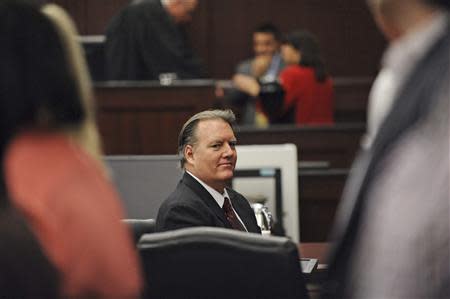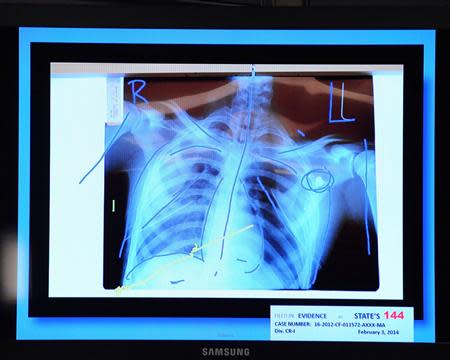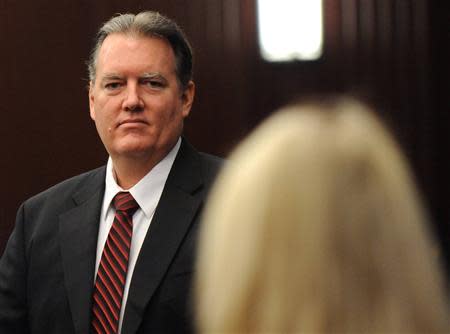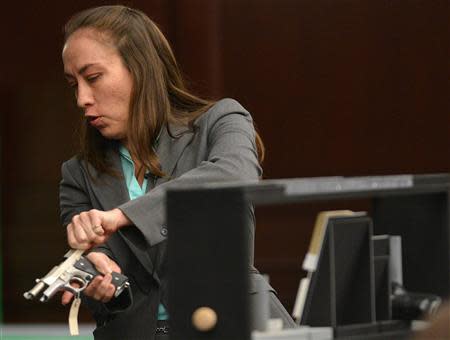Prosecution wraps up case in Florida loud music murder trial
By Susan Cooper Eastman JACKSONVILLE, Florida (Reuters) - Florida prosecutors wrapped up their case on Monday against a middle-aged white man accused in the shooting death of a black teenager during an argument over loud rap music, a case that has reignited debate over the state's self-defense laws. Jurors on Monday were shown photos of the body of the dead teen, Jordan Davis, as the prosecution sought to show he was in a defensive position when he was shot and never represented a threat. Michael Dunn, a 47-year-old software engineer, is being tried in state court on one count of first-degree murder, three counts of attempted first-degree murder and one count of firing a deadly missile into an occupied vehicle for the shooting death of Jordan Davis, 17, on November 23, 2012. Prosecutors said Dunn over reacted in his anger over loud music coming from an SUV carrying Davis and three friends, who had stopped for cigarettes and chewing gum at a gas station. The defense, which kicked off its case on Monday by calling character witnesses in support of Dunn, said in opening arguments that Dunn believed his life was in danger and he was justified in using deadly force under the state's stand your ground self-defense law. Several character witnesses testified that Dunn was a "calm" man. Randy Berry, who taught him how to fly a plane, said he saw Dunn stay calm under stress, especially when they were doing aeronautic stunts. In presenting their case, prosecutors called witnesses who testified that the argument broke out when the teens pulled into the gas station in a red Dodge Durango, listening to rap music with the volume turned loud. Dunn and his fiancée, Rhonda Rouer, stopped at the same gas station store on the way back to their hotel after attending the wedding of Dunn's son. Dunn parked his 2009 Volkswagen Jetta beside the Durango. An expletive-laced altercation followed. Several prosecution witnesses said they heard a man, whom they believed was Dunn, say "You're not going to talk to me that way," before Dunn opened fire. Dunn's lawyer, Cory Strolla, says he opened fire only after seeing what looked like the barrel of a gun or a lead pipe through the back passenger window and that he was acting in self-defense as Davis was about to get out of the car. Police found no weapon in the Durango, although Dunn's attorney said in his opening statement that the teens had time to discard any weapon before police arrived. Strolla has not informed the judge if Dunn plans to take the stand in his own defense. The case has drawn comparisons with the prosecution of George Zimmerman in the death of Trayvon Martin in Florida in 2012. In both cases, the victims were black teens killed by men who said they believed their lives were in danger. In an effort to bolster its case that Davis was not acting aggressively, prosecutors called assistant medical examiner Stacy Simons on Monday to testify that Davis was leaning away from Dunn when the bullet entered his body. The prosecution says the first three bullets fired that night entered the Durango's rear passenger door in a tight cluster, passing through the metal and entering Davis' body between his abdomen and his chest cavity, moving on an upward track through his body to lodge just under his left armpit. Simons suggested Davis' body was moving away from Dunn when the shots were fired. "You have time make evasive moves, to move away when you hear the gunshots," she said. "The body will change position," she added, using her own body to demonstrate for the jury the trajectory of the bullet. Strolla suggested that the bullets might have struck Davis when he was trying to leap back inside the Durango. (Writing by Paul Thomasch; Editing by David Adams and Dan Grebler)




